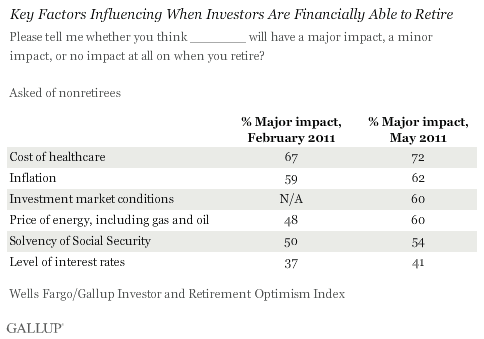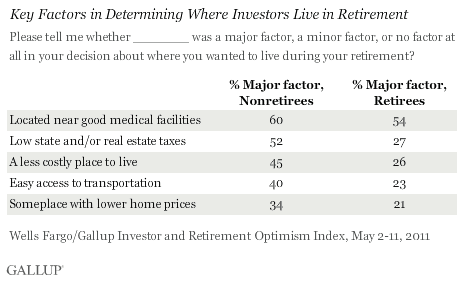PRINCETON, NJ -- Seventy-two percent of nonretired U.S. investors say the cost of healthcare is a major determinant of when they retire, according to the most recent Wells Fargo/Gallup Investor and Retirement Optimism Index poll. These Americans rank healthcare above the five other factors tested in the survey.

Notably, the percentage of investors who said the price of energy will have a major impact on the timing of their retirement rose 12 percentage points between February and May.
In the May 2-11 survey, investors -- defined as those having $10,000 or more of investable assets -- represent the top one-third of Americans in terms of investable assets.
Medical Care Surfaces as Main Issue in Where Investors Will Retire
Sixty percent of nonretired investors say being located near good medical facilities will be a major factor in determining where they will live in retirement. This is consistent with the 54% of current retirees who say healthcare was a major determinant of where they decided to retire. Among the four other factors evaluated, nonretirees ranked low state and/or local real estate taxes second, at 52%. But, no other factor was nearly as important as healthcare as far as current retirees are concerned.

Nonretired Investors Place Importance on Their Homes
The May investor poll asked nonretirees and retirees a number of additional questions about housing and retirement. Key findings include:
- Most retired American investors surveyed own their home (93%) and a majority feel it is now worth more than when they bought it (75%).
- Most nonretired Americans have a mortgage (80%), while 19% have paid off their mortgage.
- Eighty-six percent of nonretired investors feel it is "very" or "somewhat important" that they have their mortgage paid off when they retire.
- Another 58% of nonretired investors see their home as an investment asset that will help fund their retirement. Of those, 42% say their home will help fund their retirement by providing them with a place to live and 39% say it is "an asset to sell to add to retirement funds."
- About one in three nonretired investors (31%) say they would consider renting throughout their retirement.
Implications
As Americans live longer, the cost and quality of the healthcare available to them becomes increasingly important, resulting in a strong tie-in between healthcare and retirement.
Politically, this relationship tends to reinforce the notion that proposals to alter the healthcare system -- whether they involve overall healthcare reform or new proposals to alter Medicare in the future -- are the "third rail of American politics." In fact, the political heat may be hotter now than ever before, but that may make it even more important to address these issues. Such proposals are of major concern not only to those who are retired, but also to all Americans considering when and where they will retire.
The importance investors place on access to healthcare in retirement may mean the quality of healthcare facilities is as important to them when they consider where to retire as is the importance of good local schools to many parents when deciding where to live. Communities that want to attract retirees may want to consider a renewed focus on the quality and availability of local healthcare as a key marketing point. This may also be important to nonretired investors who select a place of employment with an eye toward eventual retirement -- particularly as the nation moves more toward a virtual economy in which workers have more flexibility in where they work.
The strong link between healthcare and housing is likely to garner increasing attention as baby boomers consider when and where to retire, particularly when the U.S. economy and housing begin to experience a real economic recovery.
Survey Methods
The Wells Fargo/Gallup Investor and Retirement Optimism Index results are based on questions asked on the Gallup Daily tracking survey of a random sample of 1,099 U.S. adults having investable assets of $10,000 or more from May 2-11, 2011.
For results based on the total sample of investors, one can say with 95% confidence that the maximum margin of sampling error is ±3 percentage points.
For results based on the sample of 672 nonretirees, the maximum margin of sampling error is ±4 percentage points.
For results based on the sample of 421 nonretirees, the maximum margin of sampling error is ±5 percentage points.
Interviews are conducted with respondents on landline telephones and cellular phones, with interviews conducted in Spanish for respondents who are primarily Spanish-speaking. Each sample includes a minimum quota of 400 cell phone respondents and 600 landline respondents per 1,000 national adults, with additional minimum quotas among landline respondents for gender within region. Landline telephone numbers are chosen at random among listed telephone numbers. Cell phone numbers are selected using random-digit-dial methods. Landline respondents are chosen at random within each household on the basis of which member had the most recent birthday.
Samples are weighted by gender, age, race, Hispanic ethnicity, education, region, adults in the household, and phone status (cell phone only/landline only/both, cell phone mostly, and having an unlisted landline number). Demographic weighting targets are based on the March 2010 Current Population Survey figures for the aged 18 and older non-institutionalized population living in U.S. telephone households. All reported margins of sampling error include the computed design effects for weighting and sample design.
In addition to sampling error, question wording and practical difficulties in conducting surveys can introduce error or bias into the findings of public opinion polls.
For more details on Gallup's polling methodology, visit www.gallup.com.
